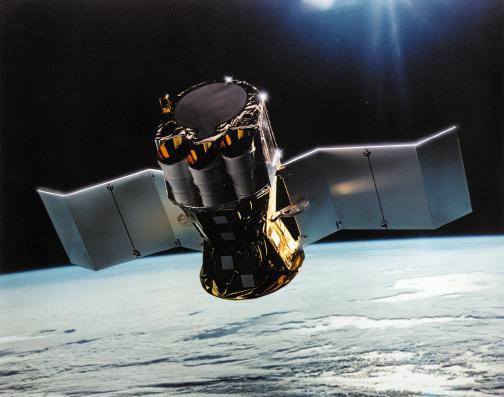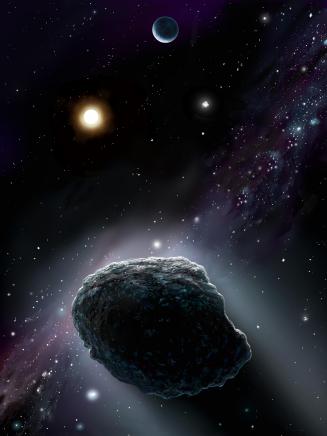
Smithsonian Astrophysical Observatory |
That leads scientists to consider the possibility that another planetary system -- beyond our own Solar System -- possesses water, an ingredient thought to be necessary for life as we know it.
Astronomers refer to CW Leonis as IRC+10216. It is located at a distance of about 200 parsecs from Earth. That's 650 lightyears away. [Explanation of a lightyear]
In the infrared light spectrum, CW Leonis is the brightest star in the sky after our own star, the Sun. The aging star is estimated to be somewhere between 1.5 and 4 times the mass of our Sun.
Astronomers had not expected the carbon-rich star to contain significant amounts of water. However, NASA's Submillimeter Wave Astronomy Satellite (SWAS), an orbiting radio observatory, detected a vast concentration of water vapor around the star.
Dying, but growing rapidly. CW Leonis has burned out the nuclear fuel supply at its core and is now burning the remaining hydrogen and helium in the thick shells surrounding its core rich in carbon.
When that happens, a star begins to shed its outer layers and expands into a Red Giant.
By the time a star has reached this point in its evolution -- called the asymptotic giant branch or AGB phase -- its radius has increased by a factor of several hundred to a thousand.
Bloated Red Giant. In fact, CW Leonis has bloated out to a radius comparable to the size of Jupiter's orbit. That's about 5 astronomical units (AU). One AU is the distance between the Earth and the Sun.
CW Leonis has been orbited by a collection of small icy bodies much like our Solar System's Kuiper Belt, which is a swarm of icy debris beyond the orbit of the planet Neptune.
While expanding into a Red Giant, CW Leonis' luminosity has increased by as much as 100 and 3000 times over a few hundred thousand years. The rapid rise has heated a previously undisturbed collection of orbiting icy bodies (comets) surrounding the star, triggering an outbound wave of evaporation.

SWAS, a NASA Small Explorer Project (SMEX) studying the chemical composition of interstellar gas clouds, was launched to a low Earth orbit on December 09, 1998. Its main objective is to survey water, molecular oxygen, carbon and isotopic carbon monoxide emissions from a variety of galactic star-forming regions. The SWAS Science Operations Center is located at the Harvard-Smithsonian Center for Astrophysics in Cambridge, Massachusetts. This is a Smithsonian Astrophysical Observatory artist's conception of the SWAS spacecraft in low Earth orbit. |
As CW Leonis burns its nuclear fuel supply and expands, shedding material from its outer layers, it may become a planetary nebula in about 10,000 to 30,000 years, scientists suggest.
SWAS. Meanwhile, NASA is using a satellite called SWAS, which stands for Submillimeter Wave Astronomy Satellite. It studies interstellar gas clouds and their chemical composition.
The primary objective of SWAS is to survey water, molecular oxygen, carbon and isotopic carbon monoxide emission in a variety of galactic star forming regions.
We know that, occasionally, a comet comes in close to our Sun and starts to vaporize. In the case of CW Leonis, that star is so much more luminous that our Sun that comets start to vaporize even at a distance as great distance as that of the Kuiper Belt from our Sun.
The dying CW Leonis is not a threat to Earth. It is about 500 light years from Earth, located in the constellation Leo.
Witnessing apocalypse. Astronomers are witnessing the type of apocalypse that is likely to befall our own planetary system.
In about six billion years, our Sun will exhaust its hydrogen fuel supply and expand into a Red Giant like CW Leonis, incinerating the nearby planets along the way. Even faraway Pluto will be vaporized, leaving a cinder of hot rock.
The CW Leonis observations suggest that other planetary systems are like ours. So far, in recent years, more than sixty planets have been discovered near various stars outside the Solar System.
Their compositions remain a mystery. Many might hold water just like many bodies in our Solar System.
Scientists hope to gain from the dying star a better understanding of the evolution of planetary systems like our own Solar System.
Water is a sign of life as we know it. Scientists want to know if planets similar to ones in our Solar System once existed around that star and if life existed there.

NASA's Deep Impact comet mission artist visualization of a comet nucleus 1.5 AU from the Sun. |
The water scientists believe they are seeing near CW Leonis probably is being vaporized from the surfaces of nearby orbiting comets -- dirty snowballs that are composed primarily of water ice.
Several hundred billion comets, located in the far reaches of the CW Leonis star system, would have to have been there to produce the intense concentration of water vapor.
The mass is comparable to the quantity of water estimated to have been in the Kuiper Belt during the infancy of our solar system.
In the search for life outside our own Solar System, the astronomer's mantra is, "follow the water."
Will the research on the dying star help us better understand our own Sun six billion years from now when it burns out its nuclear fuel supply and expands beyond the orbit of the planet Earth, sizzling whatever is in its path?
Such expansion and evaporation seems possible in our Solar System becuase we see it in a star system similar to ours -- the CW Leonis system.
Learn more about SWAS and radioastronomy:
NASASWAS FactsBall Aerospace
Small Explorer Program
NSSDC SWAS Public Data ArchiveSWASRadioastronomy
Track SWAS in orbitRadioastronomy, Star Formation, and the Interstellar Medium
Keystone Oaks High School Cooperative Satellite Learning Project
| Top of this page | More stories | Deep space main page | Space Today Online cover |